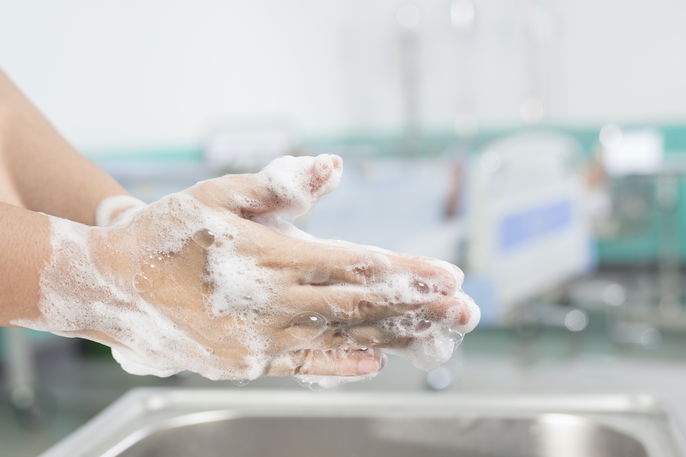Chlorhexidine is a medication with antimicrobial action, which prevents the growth and development of bacteria on the skin and mucous membranes. It is widely used as an antiseptic to disinfect hands and skin prior to surgery, but can also be applied to prevent wound infections.
When administered in high doses, chlorhexidine coagulates the proteins found in the bacteria. In lower doses, it ruptures the membranes of the bacteria, leading to bacterial death.
Chlorhexidine can be purchased in pharmacies or health stores in different formulations and dilutions. It is found in the form of an aqueous or alcoholic solution, spray or mouthwash. This medication should only be used as directed by a doctor or dentist.

What it's for
Chlorhexidine can be used for:
- Cleaning the newborn's skin and umbilical cord to prevent infections
- Vaginal disinfection for obstetric procedures
- Hand disinfection and skin preparation for surgery or invasive medical procedures
- Cleaning and disinfection of wounds and burns
- Oral mouthwash for periodontal disease and mouth disinfection to prevent pneumonia associated with mechanical ventilation
- Preparation of dilutions for skin cleansing
Solutions that require diluting should be adhered to as prescribed by your doctor.
How to use
Chlorhexidine should only be used on the skin or mucous membranes, as advised by the doctor.
1. Chlorhexidine disinfectant
Chlorhexidine disinfectant can be used to clean and disinfect hands in hospital settings by doctors and other healthcare professionals. It can also be used to clean and prep the patient's skin before surgery.
To use chlorhexidine disinfectant, apply the product to to the hands and forearms and spread it over the skin. Apply it in circular motions for 3 minutes and then rinse off with water.
Chlorhexidine disinfectant can be found in the form of an alcoholic or aqueous solution, or liquid soap containing 0.5 to 4% chlorhexidine digluconate.
2. Chlorhexidine spray
Chlorhexidine spray is indicated for cleaning and disinfecting small wounds on the skin, and can be applied 2 to 3 times a day.
To apply chlorhexidine spray, position the bottle at a distance of approximately 5 to 10 cm from the wound, and press the spray valve 2 to 3 times, or more, depending on the size of the wound.
Chlorhexidine spray contains 10 mg of chlorhexidine digluconate for each mL of solution (which is equivalent to 1% chlorhexidine).
3. Chlorhexidine solution
Chlorhexidine solution is typically used on wounds and applied 3 to 4 times a day. You can cover the affected area with gauze or other dressings, as directed by your doctor.
Use a clean and dry gauze pad, cotton ball or cotton swab to apply the chlorhexidine solution. Avoid touching the tip of the bottle to the wound, and do not dilute the chlorhexidine in water or other liquids.
Chlorhexidine solution contains 10 mg of chlorhexidine digluconate for each mL of solution.
4. Chlorhexidine mouthwash
Chlorhexidine mouthwash can be prescribed by a dentist to gargle and rinse the mouth. Prepare 15 mL of the mouthwash and gargle for 30 seconds, twice a day (in the morning and evening) after brushing and flossing, then spit it out. It is important not to rinse your mouth with water after using chlorhexidine mouthwash, as this may reduce its effectiveness.
Mouthwash that contains chlorhexidine helps eliminate bacteria that causes gum inflammation. It also reduces the formation of plaque and improves bad breath.
Possible side effects
Although it is generally well-tolerated, chlorhexidine can cause side effects such as blistering or peeling skin, redness, burning, itching or swelling.
Chlorhexidine mouthwash can cause irritation in the mouth, stains on the surface of the teeth, a metallic taste in the mouth, burning, loss of taste, peeling of the mucous membrane and allergic reactions. Prolonged use should be avoided, and it should only be used as prescribed by a dentist.
Although it is rare, chlorhexidine can also cause a serious allergic reaction that requires immediate medical attention. If you experience symptoms like difficulty breathing, wheezing, cold sweats, severe dizziness, a feeling of a closed throat, itching or swelling in the mouth, tongue or face, you should seek urgent medical attention.
Contraindications for use
Chlorhexidine should not be used by pregnant or breastfeeding women, or by people who are allergic to chlorhexidine or any other components in its formula.
Furthermore, chlorhexidine should not be applied to the eyes or ears, and care should be taken when applying to skin around these areas. In case of accidental contact with eyes or ears, rinse thoroughly with water.






























